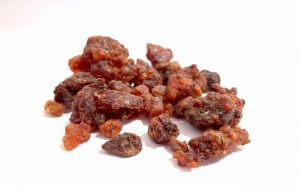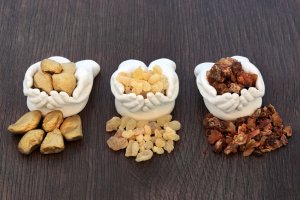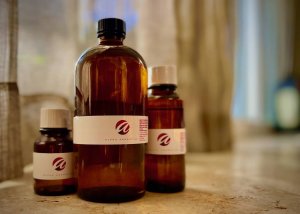Down through the ages, perfumers have recognized the mesmerizing power of myrrh. It is believed to have originated in parts of Arabia, Somalia and Ethiopia.
Our master perfumers recognize and respect its rich and colorful past dating back to the days when the world was young.
The name derives from the Arabic word, murr, meaning bitter. Also known as Bol, Bola, Hirabol, Merra and Gum Myrrh, this warm, spicy and vibrant fragrance ingredient is steeped in ancient legends and historical record.
One of the gifts bestowed on the infant Jesus by The Three Kings to honor his birth along with gold and frankincense, myrrh was highly coveted as a commodity that was bought and sold along the ancient trade routes.

Egyptian historical records on the walls of the tomb of Queen Hatshepsut depict her homage to the god, Amon, and how she secured his eternal pleasure by planting myrrh trees all-around his temple.
Legends abound about its sacred power and esteemed character. One enduring Greek and Syrian folktale suggests that its name comes from the Greek and Syrian myth about King Thesis’ daughter, whose name was Myrrha.
It is said that the gods turned her into a myrrh tree to save her from her father’s cruel wrath and that the resin that flows from the tree are her eternal tears.
What’s The Difference Between Myrrh and Frankincense?
These two resins bear both similarities and differences. They are often used in tandem, and they both derive from the gummy sap that seeps from the Boswellia and Commiphora trees after the bark is cut.
Fragrances are both gum resins and were often burned together in incense, but myrrh is bitter while frankincense is sweet with citrus nuances.

Myrrh was used more in perfume and medicine and is most often associated with death, burial, bitterness, healing and anguish. The ancient Egyptians used myrrh as a sacred ingredient in their embalming rituals.
Our master perfumers at Alpha Aromatics have come to rely on the smooth, sensual, enduring and unforgettable scent of myrrh, which is harvested via steam distillation by extracting the oil from the gum.
This is done by repeatedly wounding the tree, which forces it to “bleed” and secrete the desirable resin, which hardens and closes the wound.
A Few Fascinating Facts About Its History and Significance
1. Myrrh Was Once A Powerful Analegesic
Used to alleviate pain and clean wounds for more than 2,000 years, myrrh was only replaced with the European discovery of morphine in 1803.
2. The Myrrh Tree Has Numerous Monikers And Grows In Desert Regions
The thorny, spiky myrrh shrub is also known as: the Gum Tree; the Didthin Tree; the Guggal Gum Tree; The Guggal Resin tree; and the Didin Tree. Harsh winds and challenging heat can cause its thick trunk to grow into its distinctive knotty and twisted appearance. According to the American Botanical Council, the tree can grow up to nine feet tall.
3. Myrrh Has Holy Significance
In addition to being one of the revered gifts of the Magi, myrrh was one of the original ingredients found in Ketoret, which was the fabled incense used to scent the First and Second Temples of Jerusalem. It was also a sacred ointment oil used in the religious ceremonies of various ancient cultures.
4. Myrrh Has Meaning in Chinese Medicine
Traditional Chinese physicians have long prescribed myrrh as a treatment for a variety of medical conditions ranging from arthritis and rheumatic issues to circulatory problems and menopause.
5. Myrrh Is An Ancient Symbol Of Suffering
This is why since the beginning of time myrrh has been associated with ceremonies associated with death such as funerals. Myrrh resin was burned in combination with frankincense over hot coals in urns placed on top of coffins. The rising smoke made a sweet, warm and woody cloud of scent. This blend was also used often in meditation and prayer.
Myrrh In Perfumery Then And Now
Incense was the world’s first perfume, dating back some 4,000 years ago to ancient Mesopotamia where a cuneiform tablet identified a woman named Tapputi as the first recorded perfume maker.

The oldest perfume factory in the world was discovered by archaeologists in Cyprus back in 2003. Vessels still retained traces of smooth lavender, balsamic pine, sharp, woody rosemary, and fresh, slightly pungent coriander.
Myrrh is considered a robust scent ingredient that is extremely arousing when it reaches human nostrils.
It is smooth and erotic, and can greatly enhance the power of a fragrance, but it requires the deft, light touch of an experienced master perfumer because it can be overwhelming.
This enigmatic, licorice-nuanced and earthy substance blends well with spicy, fruity bergamot, rich intense jasmine, musky, romantic rose, bitter, somewhat salty anise and pungent spices.
Deeply atmospheric, fragrances featuring myrrh can inspire fantasy, adventure and derring-do albeit only in the mind’s all-seeing eye.
Myrrh is intriguing, and as a perfume facet is appealing to both men and women.

It is a member of a family of fragrances once known as Oriental in classification on that iconic fragrance wheel.
Due to current societal implications, the name has been changed to Ambrée (or Amber), and it encompasses a wide variety of notes that include: warm, honeyed amber, creamy sandalwood, sugary nutty coumarin, floral, powdery orris, lush, elegant vanilla and green, balsamic gum resins. Fragrances within this family are generally seductive, heavy, warm and rich.
They linger sensually on the skin and are long lasting. As such, they are more suited to after dark and the wee small hours of the morning.
One of our most recently-composed fragrances featuring myrrh is featured below.
Indonesian Patchouli Amber
A scent appealing to both sexes, head notes stream with facets of energizing citrus and exotic, sweet-smelling blooms. A warm, intimate heart note soon follows dominated by velvety, sugary Indonesian patchouli, which ultimately melds into a rich dry down of lush vanilla, creamy sandalwood, dry cedar wood, aromatic frankincense and woody, inviting and pungent myrrh.
In Conclusion
We are a leader and pioneer within the perfume industry and known all across the globe as a manufacturer and purveyor of fine fragrances.
Our compositions have a wide range of uses and includes everything from fine perfumes, personal care products and candles and diffusers to scents that are incorporated into home products and odor neutralizers.

Situated in suburban Pittsburgh, Pennsylvania, we provide services for private label manufacturers, custom packaging companies and toll blending (the specialty service of custom mixing a company’s unique formula into a final product), along with an array of product manufacturers across many industries.
With an enduring respect for the mysterious and delicate character of perfume, our trained chemists, just as all those who preceded them, have built upon the concept that perfume represents the only accessory that is always present and yet never visible.
Its secret language must be experienced in order to be understood, and it must be developed painstakingly and precisely, reflecting an art form that is as old as time.
If you’d like to add the timeless appeal of Myrrh to your product or product line, call our teams today! They can address any of your fragrance needs, no matter how large or small.
 alpha aromatics®
alpha aromatics®